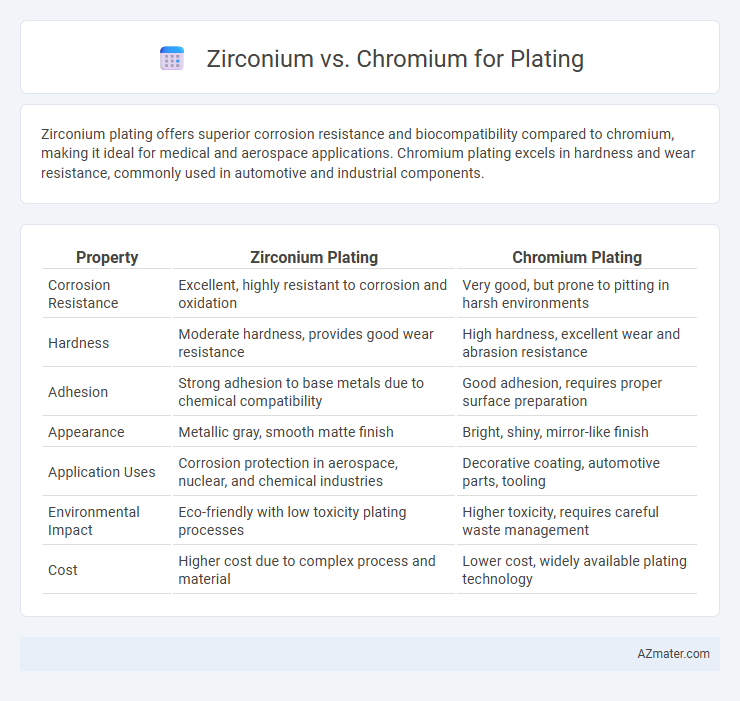Zirconium plating offers superior corrosion resistance and biocompatibility compared to chromium, making it ideal for medical and aerospace applications. Chromium plating excels in hardness and wear resistance, commonly used in automotive and industrial components.
Table of Comparison
| Property | Zirconium Plating | Chromium Plating |
|---|---|---|
| Corrosion Resistance | Excellent, highly resistant to corrosion and oxidation | Very good, but prone to pitting in harsh environments |
| Hardness | Moderate hardness, provides good wear resistance | High hardness, excellent wear and abrasion resistance |
| Adhesion | Strong adhesion to base metals due to chemical compatibility | Good adhesion, requires proper surface preparation |
| Appearance | Metallic gray, smooth matte finish | Bright, shiny, mirror-like finish |
| Application Uses | Corrosion protection in aerospace, nuclear, and chemical industries | Decorative coating, automotive parts, tooling |
| Environmental Impact | Eco-friendly with low toxicity plating processes | Higher toxicity, requires careful waste management |
| Cost | Higher cost due to complex process and material | Lower cost, widely available plating technology |
Introduction to Zirconium and Chromium Plating
Zirconium plating offers excellent corrosion resistance and durability, making it ideal for aerospace and industrial applications, while chromium plating delivers superior hardness and an attractive, reflective finish widely used in automotive and decorative purposes. Zirconium forms a stable, non-toxic oxide layer that enhances wear resistance without compromising ductility, whereas chromium plating provides a hard, corrosion-resistant surface but may involve more complex and hazardous chemical processes. Selecting between zirconium and chromium plating depends on the specific performance requirements, environmental conditions, and aesthetic preferences of the application.
Chemical Properties and Composition
Zirconium and chromium differ significantly in chemical properties and composition, impacting their use in plating. Zirconium, a transition metal with atomic number 40, exhibits high corrosion resistance and forms a stable oxide layer (ZrO2) that enhances durability and chemical stability in plating applications. Chromium, atomic number 24, is prized for its hardness, corrosion resistance, and ability to create a distinctive, reflective chromium oxide (Cr2O3) layer, making it ideal for decorative and protective plating finishes.
Plating Process Overview
Zirconium plating involves electrochemical deposition of zirconium onto a substrate, offering excellent corrosion resistance and high-temperature stability, commonly used in aerospace and nuclear industries. Chromium plating applies a layer of chromium using either hexavalent or trivalent chromium baths, known for its hardness, wear resistance, and decorative finish in automotive and industrial tooling applications. Both processes require precise surface preparation and control of bath chemistry to ensure adhesion, uniformity, and desired physical properties.
Surface Finish and Aesthetic Appeal
Zirconium plating offers a smooth, matte surface finish with excellent corrosion resistance, ideal for applications requiring a subdued metallic appearance. Chromium plating provides a highly reflective, mirror-like finish known for its bright, shiny aesthetic and superior hardness, enhancing durability and visual appeal in automotive and decorative industries. The choice between zirconium and chromium plating depends on desired surface texture, corrosion resistance, and the specific aesthetic requirements of the application.
Corrosion Resistance Comparison
Zirconium plating offers superior corrosion resistance compared to chromium, especially in aggressive environments such as acidic or high-temperature conditions. Zirconium forms a stable, dense oxide layer that effectively prevents oxidation and enhances longevity, while chromium plating, although corrosion-resistant, can suffer from pitting and surface degradation over time. Industries requiring enhanced durability in harsh chemical exposures often prefer zirconium plating for its exceptional protective properties.
Durability and Wear Performance
Zirconium plating offers superior corrosion resistance and maintains structural integrity under high-temperature conditions, making it highly durable in abrasive environments. Chromium plating provides excellent hardness and wear resistance, creating a tough surface that withstands mechanical wear and friction effectively. While chromium excels in hardness and wear performance, zirconium's corrosion resistance enhances longevity, especially in chemically aggressive environments.
Environmental Impact and Safety
Zirconium plating offers a lower environmental impact due to its non-toxic properties and reduced hazardous waste generation compared to chromium plating, which involves hexavalent chromium, a known carcinogen with strict disposal regulations. Chromium plating processes release harmful substances that require extensive safety measures and environmental controls to prevent air and water contamination. Zirconium's safer profile minimizes worker exposure risks and aligns with stricter environmental standards, making it a more sustainable option for industrial applications.
Industrial Applications and Use Cases
Zirconium plating offers superior corrosion resistance and high-temperature stability, making it ideal for chemical processing equipment and aerospace components exposed to extreme environments. Chromium plating excels in hardness and wear resistance, commonly used for automotive parts, machine tools, and decorative finishes demanding durability and aesthetic appeal. Both metals enhance surface properties but are chosen based on specific industrial requirements such as environmental exposure and mechanical stress.
Cost Analysis and Economic Considerations
Zirconium plating generally incurs higher material and processing costs compared to chromium due to its specialized application in corrosion resistance and non-toxic coatings. Chromium offers a more cost-effective solution with well-established industrial processes, making it economically favorable for large-scale applications despite environmental concerns associated with hexavalent chromium. Evaluating long-term expenses, zirconium's durability and reduce maintenance requirements can offset initial investment, highlighting its economic advantage in high-performance or eco-sensitive industries.
Choosing the Right Plating Material
Zirconium plating offers superior corrosion resistance and biocompatibility, making it ideal for medical implants and aerospace components, whereas chromium plating provides excellent hardness and wear resistance suited for automotive and industrial tools. The choice between zirconium and chromium depends on specific application requirements such as environmental exposure, desired durability, and aesthetic finish. Evaluating factors like plating thickness, adhesion properties, and cost-effectiveness ensures optimal performance tailored to the intended use.

Infographic: Zirconium vs Chromium for Plating
 azmater.com
azmater.com